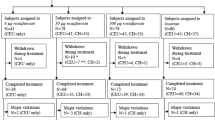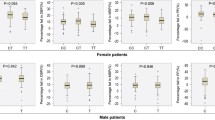Abstract
Objective
Losartan is metabolized to the active carboxylic acid metabolite EXP3174 by CYP2C9. In this study, we determined the effects of the single CYP2C9*3 variant on the pharmacokinetics and pharmacodynamics of losartan.
Methods
Seven healthy Japanese subjects (CYP2C9*1/*1, n=4 and CYP2C9*1/*3, n=3) were phenotyped with a single dose of losartan (25 mg). Blood and urine samples were collected and assayed for losartan and EXP3174. Blood pressure and pulse rate were also measured using a sphygmomanometer.
Results
The maximum plasma concentration of EXP3174 was significantly (P<0.05) lower in the CYP2C9*1/*3 (n=3) group than in the CYP2C9*1/*1 (n=4) group. Diastolic blood pressure in the CYP2C9*1/*1 group, but not that in the CYP2C9*1/*3 group except for at 6 h and 8 h, was reduced from 1.5 h to 12 h compared with the baseline level. Systolic blood pressure in the CYP2C9*1/*1 group, but not that in the CYP2C9*1/*3 group, was reduced from 1 h to 12 h compared with the baseline level. The metabolic ratio (MR) of EXP3174 concentration to the losartan concentration in plasma at 6 h post-dosing and the 4-h to 8-h urinary EXP3174/losartan MR were significantly lower in the CYP2C9*1/*3 group than in the CYP2C9*1/*1 group. The plasma 6-h MR and the 4-h to 8-h urinary MR were significantly (P<0.05) correlated with the plasma AUC ratio (AUCEXP3174/AUClosartan), with Spearman rank correlation coefficients of 0.75 and 0.89, respectively.
Conclusion
The single CYP2C9*3 variant reduces the metabolism of losartan and its hypotensive effect. Plasma MR, as well as urine MR, may be useful for phenotyping assays of CYP2C9 activity.

Similar content being viewed by others
References
Timmermans PB, Wong PC, Chiu AT, Herblin WF, Benfield P, Carini DJ, Lee RJ, Wexler RR, Saye JA,Smith RD (1993) Angiotensin II receptors and angiotensin II receptor antagonists. Pharmacol Rev 45:205–251
Lo MW, Goldberg MR, McCrea JB, Lu H, Furtek CI, Bjornsson TD (1995) Pharmacokinetics of losartan, an angiotensin II receptor antagonist, and its active metabolite EXP3174 in humans. Clin Pharmacol Ther 58:641–649
Wong PC, Price WA, Jr., Chiu AT, Duncia JV, Carini DJ, Wexler RR, Johnson AL, Timmermans PB (1990) Nonpeptide angiotensin II receptor antagonists. XI. Pharmacology of EXP3174: an active metabolite of DuP 753, an orally active antihypertensive agent. J Pharmacol Exp Ther 255:211–217
Munafo A, Christen Y, Nussberger J, Shum LY, Borland RM, Lee RJ, Waeber B, Biollaz J, Brunner HR (1992) Drug concentration response relationships in normal volunteers after oral administration of losartan, an angiotensin II receptor antagonist. Clin Pharmacol Ther 51:513–521
Sachinidis A, Ko Y, Weisser P, Meyer zu Brickwedde MK, Düsing R, Christian R, Wieczorek AJ, Vetter H (1993) EXP3174, a metabolite of losartan (MK 954, DuP 753) is more potent than losartan in blocking the angiotensin II-induced responses in vascular smooth muscle cells. J Hypertens 11:155–162
Kazierad DJ, Martin DE, Blum RA, Tenero DM, Ilson B, Boike SC, Etheredge R, Jorkasky DK (1997) Effect of fluconazole on the pharmacokinetics of eprosartan and losartan in healthy male volunteers. Clin Pharmacol Ther 62:417–425
Kaukonen KM, Olkkola KT, Neuvonen PJ (1998) Fluconazole but not itraconazole decreases the metabolism of losartan to E-3174. Eur J Clin Pharmacol 53:445–449
Miners JO, Birkett DJ (1998) Cytochrome P4502C9: an enzyme of major importance in human drug metabolism. Br J Clin Pharmacol 45:525–538
Goldstein JA (2001) Clinical relevance of genetic polymorphisms in the human CYP2C subfamily. Br J Clin Pharmacol 52:349–355
Rettie AE, Wienkers LC, Gonzalez FJ, Trager WF, Korzekwa KR (1994) Impaired (S)-warfarin metabolism catalysed by the R144C allelic variant of CYP2C9. Pharmacogenetics 4:39–42
Crespi CL, Miller VP (1997) The R144C change in the CYP2C9*2 allele alters interaction of the cytochrome P450 with NADPH:cytochrome P450 oxidoreductase. Pharmacogenetics 7:203–210
Sullivan-Klose TH, Ghanayem BI, Bell DA, Zhang ZY, Kaminsky LS, Shenfield GM, Miners JO, Birkett DJ, Goldstein JA (1996) The role of the CYP2C9-Leu359 allelic variant in the tolbutamide polymorphism. Pharmacogenetics 6:341–349
Takanashi K, Tainaka H, Kobayashi K, Yasumori T, Hosakawa M, Chiba K (2000) CYP2C9 Ile359 and Leu359 variants: enzyme kinetic study with seven substrates. Pharmacogenetics 10:95–104
Nasu K, Kubota T, Ishizaki T (1997) Genetic analysis of CYP2C9 polymorphism in a Japanese population. Pharmacogenetics 7:405–409
Ritter MA, Furtek CI, Lo MW (1997) An improved method for the simultaneous determination of losartan and its major metabolite, EXP3174, in human plasma and urine by high-performance liquid chromatography with fluorescence detection. J Pharm Biomed Anal 15:1021–1029
Yasar Ü, Forslund-Bergengren C, Tybring G, Dorado P, Llerena A, Sjöqvist F, Eliasson E, Dahl ML (2002) Pharmacokinetics of losartan and its metabolite E-3174 in relation to the CYP2C9 genotype. Clin Pharmacol Ther 71:89–98
Aithal GP, Day CP, Kesteven PJ, Daly AK (1999) Association of polymorphisms in the cytochrome P450 CYP2C9 with warfarin dose requirement and risk of bleeding complications. Lancet 353:717–719
Caraco Y, Muszkat M, Wood AJ (2001) Phenytoin metabolic ratio: a putative marker of CYP2C9 activity in vivo. Pharmacogenetics 11:587–596
Veronese ME, Miners JO, Randles D, Gregov D, Birkett DJ (1990) Validation of the tolbutamide metabolic ratio for population screening with use of sulfaphenazole to produce model phenotypic poor metabolizers. Clin Pharmacol Ther 47:403–411
Veronese ME, Miners JO, Rees DL, Birkett DJ (1993) Tolbutamide hydroxylation in humans: lack of bimodality in 106 healthy subjects. Pharmacogenetics 3:86–93
Odani A, Hashimoto Y, Otsuki Y, Uwai Y, Hattori H, Furusho K, Inui K (1997) Genetic polymorphism of the CYP2C subfamily and its effect on the pharmacokinetics of phenytoin in Japanese patients with epilepsy. Clin Pharmacol Ther 62:287–292
Ninomiya H, Mamiya K, Matsuo S, Ieiri I, Higuchi S, Tashiro N (2000) Genetic polymorphism of the CYP2C subfamily and excessive serum phenytoin concentration with central nervous system intoxication. Ther Drug Monit 22:230–232
Kirchheiner J, Bauer S, Meineke I, Rohde W, Prang V, Meisel C, Roots I, Brockmöller J (2002) Impact of CYP2C9 and CYP2C19 polymorphisms on tolbutamide kinetics and the insulin and glucose response in healthy volunteers. Pharmacogenetics 12:101–109
Shon JH, Yoon YR, Kim KA, Lim YC, Lee KJ, Park JY, Cha IJ, Flockhart DA, Shin JG (2002) Effects of CYP2C19 and CYP2C9 genetic polymorphisms on the disposition of and blood glucose lowering response to tolbutamide in humans. Pharmacogenetics 12:111–119
Sasaki M, Fujimura A, Harada K, Sunaga K, Ebihara A (1996) Clinical pharmacology of multiple-dose losartan, an angiotensin II receptor antagonist, in patients with essential hypertension. J Clin Pharmacol 36:403–408
Acknowledgements
We acknowledge the support and assistance of Sin Itoh M.D. (Department of Neuropsychiatry, University of Tokyo Hospital, Faculty of Medicine, Tokyo, Japan). This work was supported by grants for losartan and its metabolite EXP3174 from Merck Research Laboratories (Rahway, NJ, USA).
Author information
Authors and Affiliations
Corresponding author
Rights and permissions
About this article
Cite this article
Sekino, K., Kubota, T., Okada, Y. et al. Effect of the single CYP2C9*3 allele on pharmacokinetics and pharmacodynamics of losartan in healthy Japanese subjects. Eur J Clin Pharmacol 59, 589–592 (2003). https://doi.org/10.1007/s00228-003-0664-5
Received:
Accepted:
Published:
Issue Date:
DOI: https://doi.org/10.1007/s00228-003-0664-5




